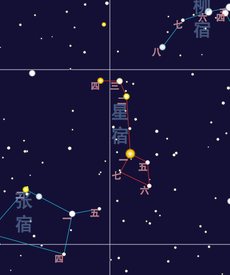
Star (Chinese constellation)
Encyclopedia

Twenty-eight mansions
The Twenty-eight Mansions , ', ' or ' are part of the Chinese constellations system. They can be considered as the equivalent to the zodiacal constellations in the Western astronomy, though the Twenty-eight Mansions reflect the movement of the Moon in a lunar month rather than the Sun in a solar year...
of the Chinese constellation
Chinese constellation
Chinese constellations are the way the ancient Chinese grouped the stars. They are very different from the modern IAU recognized constellations. This is because the IAU was based on Greco-Roman astronomy instead of Chinese astronomy....
s. It is one of the southern mansions of the Vermilion Bird
Vermilion Bird (Chinese constellation)
The Vermilion bird is one of the Four Symbols of the Chinese constellations. According to Wu Xing, the Taoist five-elemental system, it represents the fire-element, the direction south, and the season summer correspondingly. Thus it is sometimes called the Vermilion bird of the South...
.
Asterisms
| English name | Chinese name | Modern constellation Constellation In modern astronomy, a constellation is an internationally defined area of the celestial sphere. These areas are grouped around asterisms, patterns formed by prominent stars within apparent proximity to one another on Earth's night sky.... |
Number of stars |
| Star | 星 | Hydra Hydra (constellation) Hydra is the largest of the 88 modern constellations, measuring 1303 square degrees. It has a long history, having been included among the 48 constellations listed by the 2nd century astronomer Ptolemy. It is commonly represented as a water snake... |
7 |
| Celestial Premier | 天相 | Sextans Sextans Sextans is a minor equatorial constellation which was introduced in 1687 by Johannes Hevelius. Its name is Latin for the astronomical sextant, an instrument that Hevelius made frequent use of in his observations.-Notable features:... |
3 |
| Celestial Cereals | 天稷 | Vela Vela (constellation) Vela is a constellation in the southern sky. Its name is Latin for the sails of a ship, and it was originally part of a larger constellation, the ship Argo Navis, which was later divided into three parts, the others being Carina and Puppis.-Stars:... |
5 |
| Xuanyuan | 軒轅 | Leo Leo (constellation) Leo is one of the constellations of the zodiac. Its name is Latin for lion. Its symbol is . Leo lies between dim Cancer to the west and Virgo to the east.-Stars:... /Lynx Lynx (constellation) Lynx is a constellation in the northern sky, introduced in the 17th century by Johannes Hevelius. It is named after the lynx, a genus of cat. It is a very faint constellation; its brightest stars form a zigzag line.-History:... |
17 |
| Maids-In-Waiting | 御女 | Leo Leo (constellation) Leo is one of the constellations of the zodiac. Its name is Latin for lion. Its symbol is . Leo lies between dim Cancer to the west and Virgo to the east.-Stars:... |
1 |
| High Judge | 內平 | Leo Minor Leo Minor Leo Minor is a small and faint constellation. Its name means "the smaller lion", in contrast to Leo, the larger lion. Its brightest stars form a rough triangle, and it lies between the larger and more recognizable Ursa Major and Leo... |
4 |

